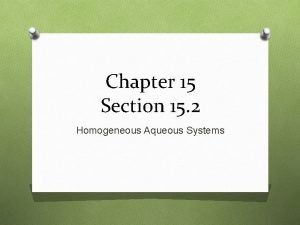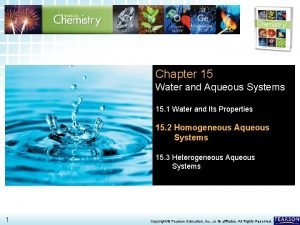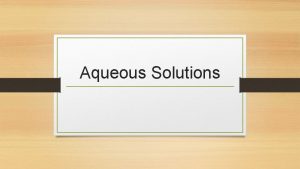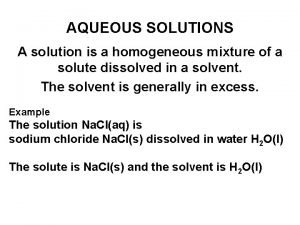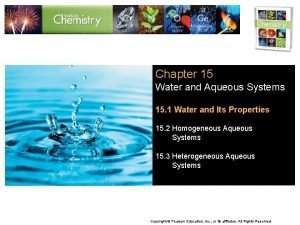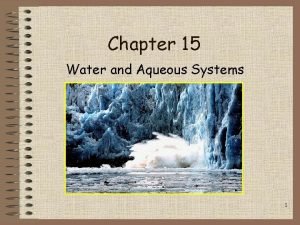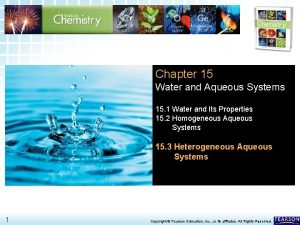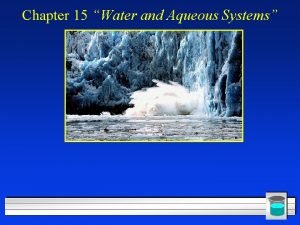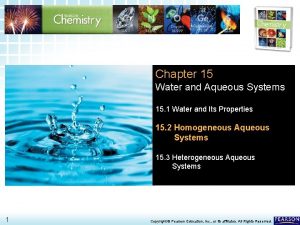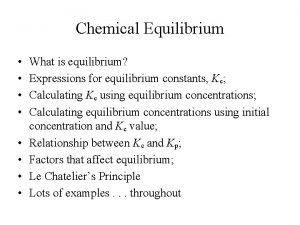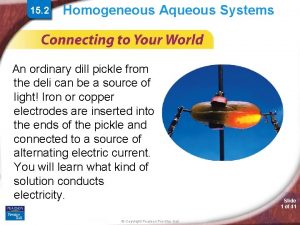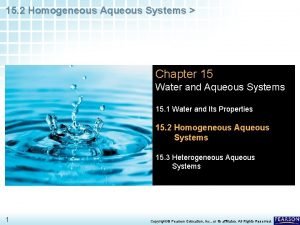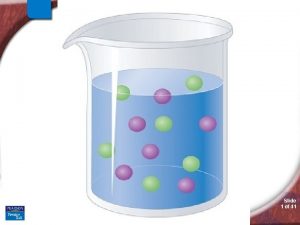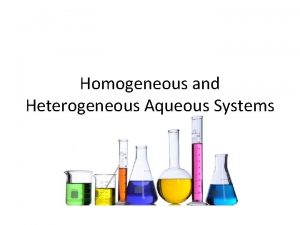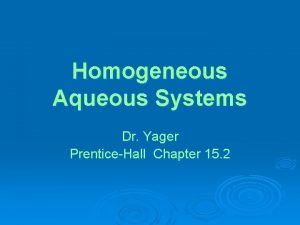15 2 Homogeneous Aqueous Systems Introduction An ordinary










- Slides: 10

15. 2 - Homogeneous Aqueous Systems Introduction • An ordinary dill pickle from the deli can be a source of light! • Iron or copper electrodes are inserted into the ends of the pickle and connected to a source of alternating electric current. • The mechanism is not fully understood, but it is clear that conduction of electricity by the pickle is an important factor. • You will learn what kind of solution conducts electricity.

3. Solvents and Solutes 15. 2 • Water dissolves so many of the substances that it comes in contact with that you won’t find chemically pure water in nature. • An aqueous solution is water that contains dissolved substances. • In a solution, the dissolving medium is the solvent. • In a solution, the dissolved particles are the solute. • A solvent dissolves the solute. The solute becomes dispersed in the solvent. • Solvents and solutes may be gases, liquids, or solids.

Solvents and Solutes (cont. ) • Recall that solutions are homogeneous mixtures that are stable. • For example, sodium chloride does not settle out when its solutions are allowed to stand. • If you filter a solution through filter paper, both the solute and the solvent pass through the filter. • Solute particles can be atoms, ions, or molecules, which have an average diameter of less than 1 nm (10 -9 m). • Substances that dissolve most readily in water include ionic compounds and polar covalent compounds.

4. The Solution Process • Water molecules are in constant motion because of their kinetic energy. • When a crystal of sodium chloride is placed in water, the water molecules collide with it. • Remember that a water molecule is polar, with a partial negative charge on the oxygen atom and partial positive charges on the hydrogen atoms. • The polar solvent molecules (H 20) attract the solute ions (Na+, Cl-)

The Solution Process (cont. ) • As individual solute ions break away from the crystal, the negatively and positively charged ions become surrounded by solvent molecules, and the ionic crystal dissolves. • The process by which the positive and negative ions of an ionic solid become surrounded by solvent molecules is called solvation. Solvation of an Ionic Solid • In some ionic compounds, the attractions among the ions in the crystals are stronger than the attractions exerted by water. • These compounds cannot be solvated to any significant extent and are therefore insoluble.

The Solution Process • Oil and water do not mix. But oil and gasoline mix. (cont. ) • Both are nonpolar, the attractive forces that hold two oil molecules together are similar in magnitude and force as those in gasoline. • As a rule, polar solvents such as water dissolve ionic compounds and polar compounds. • Nonpolar solvents such as gasoline dissolve nonpolar compounds. • “Like dissolves like”

5. Electrolytes and Nonelectrolytes • An electrolyte is a compound that conducts an electric current when it is in an aqueous solution or in the molten state. • Conduction of electricity requires ions that are mobile and thus able to carry an electric current. • All ionic compounds that are water-soluble are electrolytes because they dissociate into ions. • Ionic compounds that are insoluble can conduct electricity in the molten state. • A compound that does not conduct an electric current in either aqueous solution or the molten state is called a nonelectrolyte. • Many molecular compounds are nonelectrolytes because they are not composed of ions.

Electrolytes and Nonelectrolytes (cont. ) • Some polar molecular compounds are nonelectrolytes in the pure state, but become electrolytes when dissolved in water. • This occurs because such compounds ionize in solution. • NH 3 (g) + H 2 O (l) -> NH 4+ (aq) + OH- (aq) • Not all electrolytes conduct electric current to the same degree.

Electrolytes and Nonelectrolytes (cont. ) • The bright glow in the picture to the left shows that sodium chloride is a strong electrolyte because nearly all the dissolved sodium chloride exists as separate Na+ and Cl– ions. • A weak electrolyte conducts electricity poorly because only a fraction of the solute in the solution exists as ions.

END OF SECTION 2
 Homogeneous aqueous systems
Homogeneous aqueous systems Chapter 15 water and aqueous systems answer key
Chapter 15 water and aqueous systems answer key Are all aqueous solutions homogeneous
Are all aqueous solutions homogeneous Are all aqueous solutions homogeneous
Are all aqueous solutions homogeneous Non homogeneous differential equation definition
Non homogeneous differential equation definition Tyndall effect
Tyndall effect Water and aqueous systems chapter 15 answers
Water and aqueous systems chapter 15 answers Suspension vs solution
Suspension vs solution Chapter 15 water and aqueous systems
Chapter 15 water and aqueous systems Chapter 15 water and aqueous systems
Chapter 15 water and aqueous systems Hi
Hi
